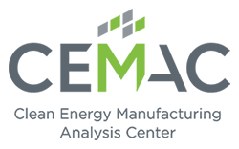Four Benchmarks We Use to Measure Clean Energy Manufacturing
February 27, 2020
By Debbie Sandor, Project Leader of CEMAC Benchmark report
Robust manufacturing supply chains are essential to meeting the rapidly growing demand for clean energy technologies around the world. For policy makers and investors, a deep understanding of these supply chains contributes to informed decision making. But you can't manage what you can't measure.
Benchmarks of Global Clean Energy Manufacturing—CEMAC's flagship report—is a first-of-its-kind effort to isolate and quantify the economic impacts of the clean energy manufacturing sector. The report establishes a baseline picture of where clean energy technologies are manufactured around the world, so we can track the development of the sector over the coming years.
"One unique aspect of Benchmarks is the focus on supply chain intermediates or 'links' as we called them, rather than just the final product."
We looked at four leading clean energy technologies—wind turbine components, crystalline silicon photovoltaic modules, automotive Li-ion batteries, and LED packages—in 12 economies that are the primary manufacturing hubs for those technologies.
One unique aspect of Benchmarks is the focus on supply chain intermediates or "links" as we called them, rather than just the final product. The intermediate processed materials and subcomponents as well as the end product for these technologies—for example, polysilcon, and PV wafers and cells for PV modules—crisscross the globe to support global demand. We created a standardized framework and methodology to disaggregate data for a specific clean energy technology into standardized links in the manufacturing supply chain. This structure facilitates communication of benchmark results, rollup of clean energy data across technologies, and provides flexibility to address the significant manufacturing differences for each clean energy technology.
The four benchmarks—or common points of reference—we developed to assess the economic impacts of clean energy technology manufacturing across the supply chain are:
- Value Added – Estimate of clean energy manufacturing contribution to national economies
- Trade Flow – Snapshot of trade activity among economies across the supply chain
- Market Size – Relative concentration of consumption of clean energy technologies
- Manufacturing Capacity and Production - Distribution of manufacturing activity and where growth may occur.
It was challenging to find data at the desired level of disaggregation for all four technologies. Consequently, the CEMAC team used 2014 as the baseline year for the report, as it is the most recent year for which complete data are available.
So what did we find?
From a national perspective, extensive domestic supply chains and higher wages help ensure that more of the money spent on clean energy technology manufacturing—for workers, investors, and governments—stays within the country.
We also found that clean energy manufacturing is a complex, global enterprise, with supply chains distributed across economies. Economies that are net importers of end products may be major exporters of upstream processed materials and subcomponents of those same technologies.
Finally, in 2014, there was generally an excess of manufacturing capacity across the supply chain, relative to global demand. Excess capacity can be used to meet potential demand growth from increased technology adoption. However, without increased demand, persistent excess capacity can place downward pressure on pricing.
These were the three biggest findings of the report, but there's a lot more to learn. Over the coming weeks, other members of the CEMAC team will dig deeper into some of the report's findings on this blog.

